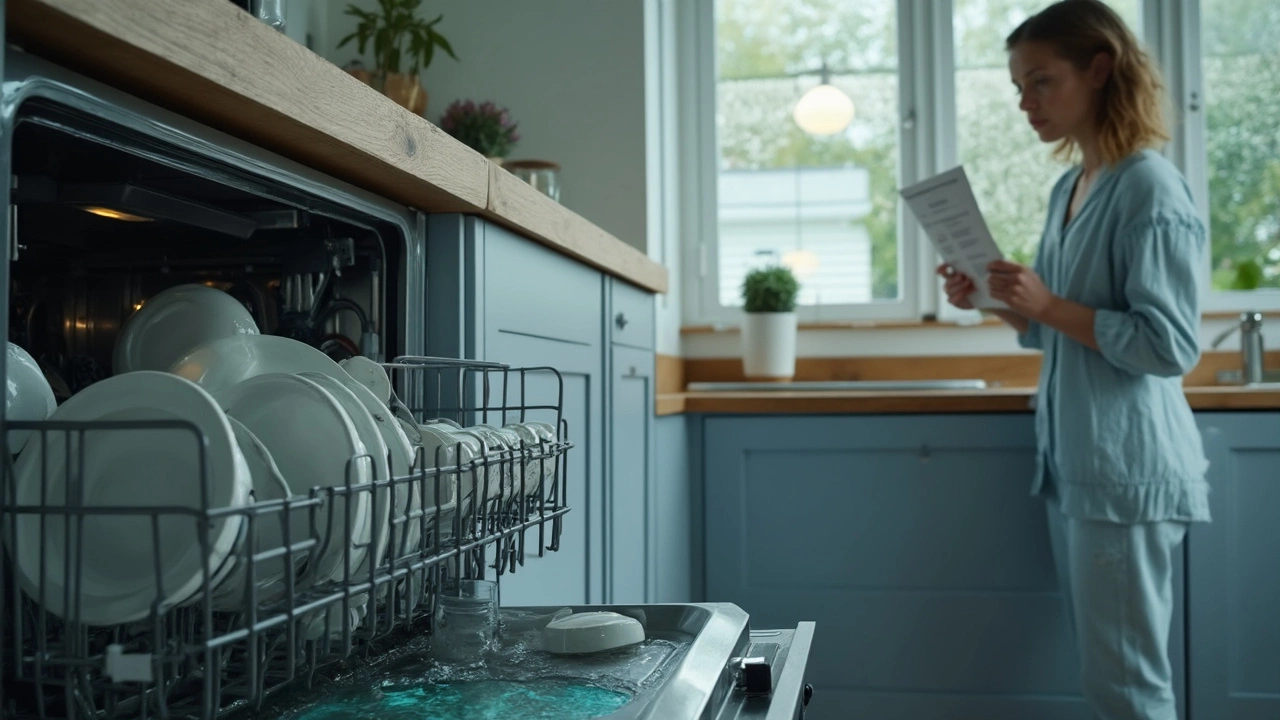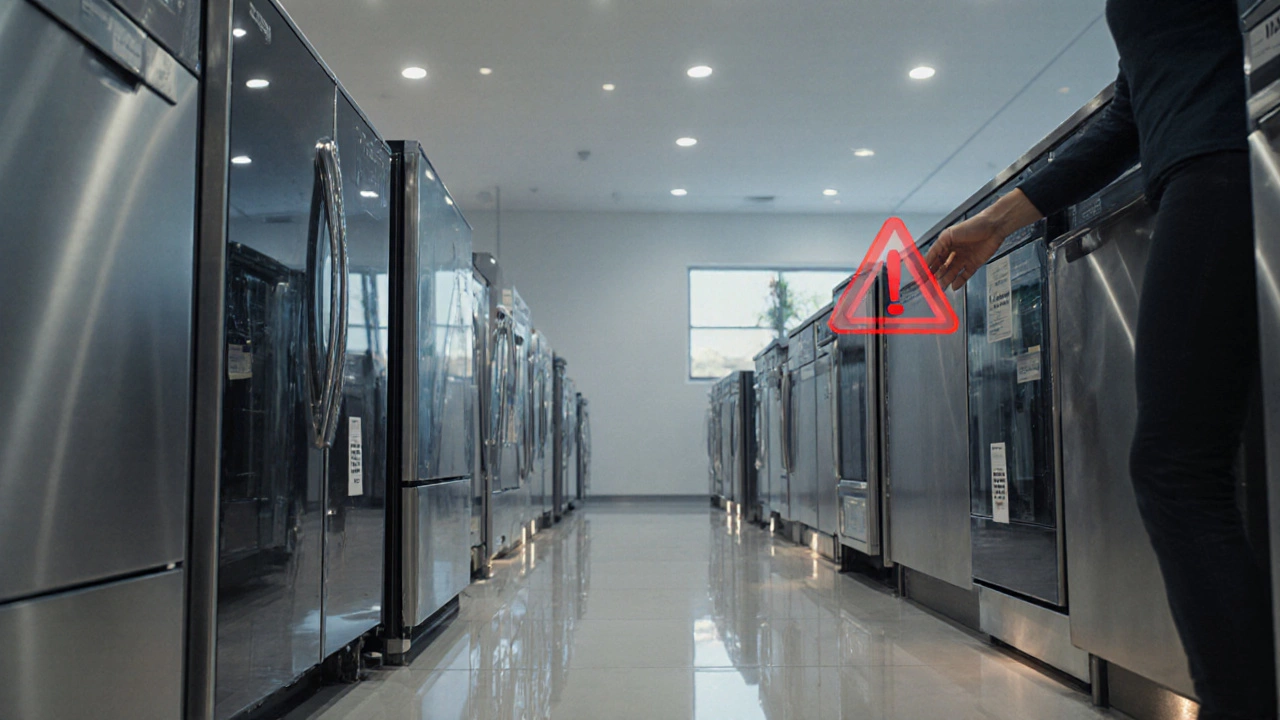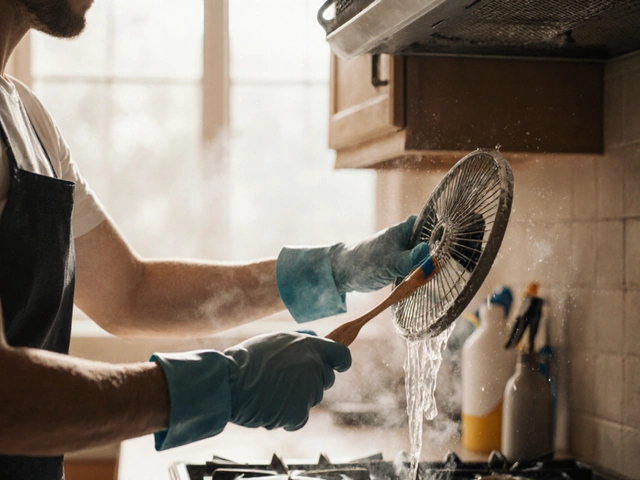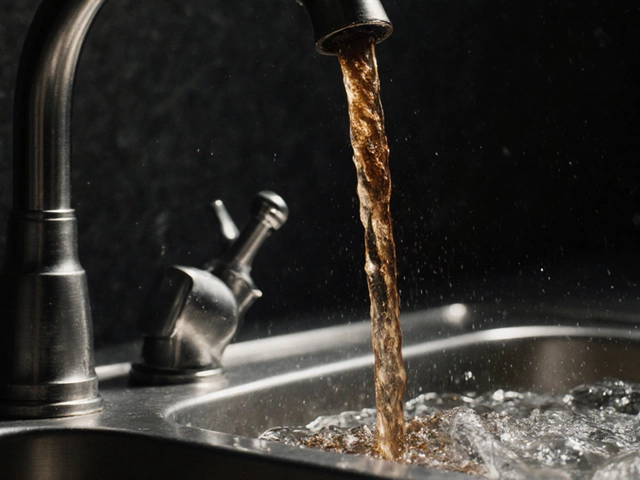Nothing kills the post-dinner mood like opening your dishwasher and finding a puddle sitting at the bottom. Sure, it’s normal for a dishwasher to have a small amount of water left after a cycle, but if you’re seeing standing water that covers the base or—worse—reaches your plates, that's a red flag. Most of the time, it's not as scary as it looks and you won't need to replace your machine.
The first thing to check: did you open the dishwasher mid-cycle or before it’s finished draining? Sometimes we all get impatient. But if you’re sure the cycle's over and there’s still water sitting there, something’s up—likely a clog or drain issue. A surprisingly common cause is a chunk of food, a piece of broken glass, or even a stray label from a can blocking things up. Don’t ignore it, though—a few minutes troubleshooting now beats having to mop the kitchen floor because things backed up further.
- Recognizing When Water Is a Problem
- Main Causes of Water at the Bottom
- Quick Fixes You Can Try Right Now
- When It’s Time to Clean Filters and Drains
- Mistakes People Make That Lead to Water Build-Up
- How to Keep Your Dishwasher Flowing Smoothly
Recognizing When Water Is a Problem
Not every drop left in your dishwasher water section means there's a problem. Dishwashers usually leave a tiny bit of water to keep the seals from drying out. But once you spot a pool of water big enough to splash or that soaks the bottom rack, something’s off.
Look for these signs it's more than just normal leftover moisture:
- More than half a cup of water sitting at the bottom after the cycle ends.
- Dirty water, with bits of food or debris floating around.
- A strong musty or rotten smell—leftover water breeds bacteria in no time.
- The cycle takes way longer than normal or doesn't finish draining.
- Your clean dishes come out with water spots or grime stuck on.
Here’s a simple fact: modern dishwashers are designed to drain almost entirely. If you run a final rinse and there’s still water sticking around, that’s a clear sign to check for a clogged dishwasher or a drain issue. Ignoring it can leave you with mold, leaks, or broken pumps later on.
| Water Amount | What It Means |
|---|---|
| Few drops/Minor puddle | Usually normal |
| Standing water > 0.5 cups | Check for clogs or drain problems |
| Murky, foul-smelling water | Drainage issue, needs fixing right away |
When the water level rises high enough to touch the heating element or you hear gurgling sounds, don’t just hope the next cycle will fix it. Grab a flashlight and take a peek under the lower spray arm—you’ll probably spot why your dishwasher repair project just moved up your weekend to-do list.
Main Causes of Water at the Bottom
If you notice a pool in the base of your dishwasher, it's usually not some mysterious malfunction. Most of the time, there are just a few main culprits behind dishwasher water not draining the way it should.
- Clogged Filter: Every dishwasher has a filter that catches food and other debris so it won’t go down the drain. If you’re skipping regular cleanings, gunk builds up fast and blocks water from flowing out. Honestly, most standing water issues start here.
- Blocked Drain Hose: That flexible hose in the back, usually under your sink, carries dirty water out of the machine. If it’s kinked, jammed with leftover food, or even frozen in winter, draining won’t happen like it should.
- Garbage Disposal Backups: If your dishwasher empties into a garbage disposal, make sure the disposal isn’t stuffed with old food or that the knockout plug (common with new installations) has been removed. A surprise here: people forget this all the time after getting a new disposal.
- Faulty Drain Pump: The drain pump does the heavy lifting to push water out. If it’s dead or struggling, water just hangs around. Pumps wear out as your dishwasher ages, especially if stuff like glass or bones gets jammed inside.
- Stuck Check Valve: Dishwashers have a check valve that helps keep used water from flowing back in after draining. If it sticks or fails, dirty water finds its way back to the bottom.
Some newer dishwashers flash error codes for these issues. But classic models? You usually have to look for the obvious clues—water pooling, weird noises during draining, or dishes that come out still dirty. According to a 2023 repair report from HomeAdvisor, the most common reason for standing water in dishwasher calls was a clogged filter—nearly 60% of the time.
| Main Cause | Frequency (%) |
|---|---|
| Clogged Filter | 59% |
| Blocked Drain Hose | 21% |
| Drain Pump Failure | 13% |
| Garbage Disposal/Check Valve Issues | 7% |
So, don’t panic. Most of these are easy to spot and pretty straightforward to fix once you know what to look for.
Quick Fixes You Can Try Right Now
Before you call up a repair guy, there are a few things you can try yourself if you spot standing water in your dishwasher. These steps are straightforward and don’t need special tools, just some patience and maybe a couple of towels.
- Check for a Clogged Drain: Pull the bottom rack out and look at the drain area. You might find food bits, pasta, or even a small utensil blocking the drain. Remove anything obvious and try running a short rinse cycle.
- Clean the Filter: Most newer dishwashers have an easy-to-remove filter at the bottom. It usually twists out. Rinse it under the tap to remove gunk and bits of food. Pop it back in securely, or you risk leaks or more clogs.
- Look at the Garbage Disposal: If your dishwasher drains into your kitchen sink’s disposal, make sure that’s not the problem. Sometimes, a clog or food jam can block the path, stopping water from leaving the dishwasher.
- Check the Drain Hose: The hose that runs from your machine to the sink can sometimes get kinked or blocked. It should have a gentle loop—no sharp bends that stop water flow. If you recently installed a new disposal or moved the dishwasher, double-check that the knockout plug inside the disposal is removed.
- Reset the Dishwasher: Sometimes, dishwashers get confused and stop mid-cycle. Try unplugging it for a minute (or flip the breaker off and on) to reset the electronics, then run a fresh rinse cycle.
A recent appliance industry survey found that about 25% of dishwasher repair calls are solved by cleaning out filters or the drain. Not too surprising—most of us don’t even know that filter exists until trouble starts.
- Always run your garbage disposal before starting the dishwasher. It keeps the drain line clear.
- Don’t overpack the bottom rack—blocking the drain with a big dish or pan is a common mistake.
- If you pull out something nasty, wear gloves. Some clogs include cracked glass or sharp food scraps.
Give these a try. Nine times out of ten, you’ll deal with the standing water in dishwasher problem without touching your wallet.
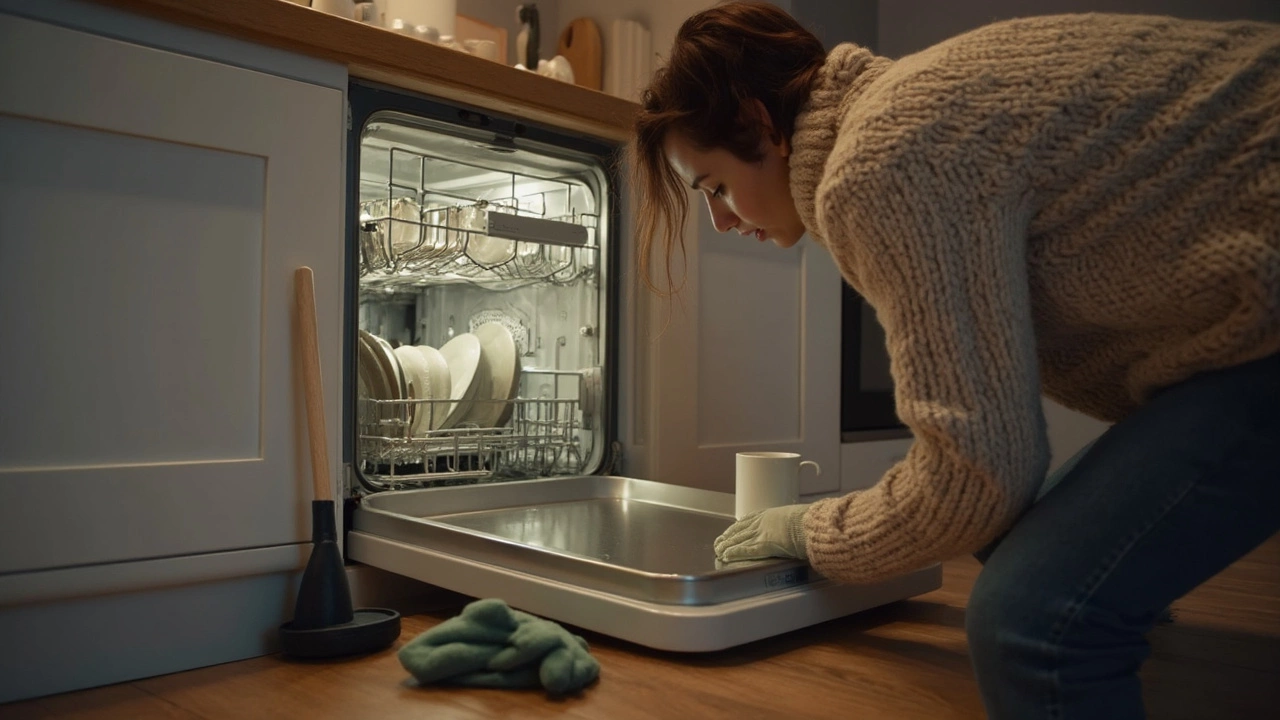
When It’s Time to Clean Filters and Drains
If you spot standing water in your dishwasher, those filters and drains should be your first stop. You’d be surprised how much gunk ends up clogging things down there—even in just a few months of regular use. Most dishwashers come with one or two filters on the floor of the machine. Their job? Catching big food bits and keeping them out of the pump, so your dishwasher water drains smoothly.
Here’s the simple test—if your dishwasher smells funky, your dishes come out greasy, or you see that puddle sticking around after a cycle, it’s probably time to give the filters and drains a good clean. Many folks go months, or even years, without touching their filter. But experts recommend checking them every month if you use your dishwasher a lot.
Here’s how to easily clean the filters and drains in most machines:
- Turn off and unplug your dishwasher—safety first.
- Open the bottom rack and look for the round or rectangular filter in the base. Twist or lift it out gently.
- Rinse the filter under hot water. If it’s really grimy, use a soft brush and a bit of dish soap.
- Check the area where the filter sits for built-up food scraps, glass, or even a plastic wrapper. Wipe it clean.
- Look down the drain outlet—if you see stuff stuck, carefully pull it out with your fingers or a small piece of wire. Don’t force anything; you don’t want to damage the pump.
- Put the filter back. Make sure it sits snugly so nothing gets through that shouldn’t.
Bonus tip: If your machine is older or has never been cleaned, you might find something that looks like wet sand in the filter. That’s mineral build-up from hard water. Running your dishwasher empty on the hottest cycle with a cup of white vinegar can help break that down.
If you’re still having trouble with that dishwasher water not draining after cleaning the filters, you might have a deeper clog in the drain hose. At that point, you’ll probably want to pull the machine out and disconnect the hose—or call in backup.
| How Often to Clean | Situation |
|---|---|
| Monthly | Daily or frequent dishwasher use |
| Every 2-3 months | Light or occasional use |
| Immediately | After a big holiday meal or if you notice standing water, odd smells, or dirty dishes |
Cleaning your dishwasher filter and drain takes less than 10 minutes, but it can solve most common dishwasher repair headaches before they get expensive.
Mistakes People Make That Lead to Water Build-Up
You’d be surprised how often simple mistakes lead to that nasty dishwasher water pooling at the bottom. Most of them happen before you even hit the start button.
For starters, let’s talk loading habits. Stuffing the racks to the brim? Plates covering the filter or spray arms? Guilty as charged. When you block those parts, your dishwasher struggles to drain and rinse, so water hangs around.
Then there’s skipping out on filter checks. Most folks figure their dishwasher handles everything, but dishwashers need a hand, too. If you never clean out the filter—even just once a month—bits of pasta, paper labels, and seeds get caught, slowing drainage and keeping water in the machine.
Another easy-to-miss error is forgetting to scrape off big food chunks. Dishwashers can handle crumbs, but not entire globs of mashed potatoes. That stuff clogs the drain, plain and simple.
Here’s a quick list of top mistakes that can make a mess inside your dishwasher:
- Jamming utensils, plastic lids, or measuring cups low enough to block the lower spray arm.
- Putting bowls or pots face-down right over the filter.
- Not checking for stray pieces of glass or food that fall under the bottom rack.
- Skipping regular filter rinses.
- Running back-to-back cycles without letting it cool off a few minutes in between (yep, that can mess with sensors on newer models).
A not-so-well-known fact: about 80% of dishwasher issues that involve standing water could be solved just by keeping the filter clear and not overloading. Here’s a simple table that breaks down which mistake causes the biggest headaches for dishwasher repair pros:
| Mistake | Chance of Causing Water Build-Up |
|---|---|
| Blocked Filter | High |
| Overstuffed Dishwasher | High |
| Wrong Item Placement | Medium |
| Dirty Drain Hose | Medium |
| Neglected Regular Cleaning | High |
Keeping these slip-ups in check goes a long way toward saving your kitchen from soggy surprises. Prevention beats repair every time—just a little attention and your dishwasher will thank you with dry, clean results.
How to Keep Your Dishwasher Flowing Smoothly
Keeping your dishwasher water where it belongs is all about a bit of regular maintenance and smart habits. This isn’t one of those chores that takes forever, but it can seriously cut down on future dishwasher repair bills and save you from funky odors or flooded floors.
First, make it a habit to scrape big food bits off plates before loading them. You don’t need to rinse dishes spotless, but those pasta chunks or stray bones can clog your drain fast. A lot of newer dishwashers have built-in filters instead of grinders, and they can get blocked up if you treat your dishwasher like a trash can.
Checking and cleaning the filter once a month goes a long way. Here’s how to do it:
- Pull out the bottom rack so you can reach the filter (usually in the back or center of the tub).
- Twist and lift out the filter—most pop out with a simple turn.
- Rinse it under hot water and use a soft brush to get gunk out.
- Pop it back in place.
If your dishwasher troubleshooting keeps coming back to slow draining, check the hose. The drain hose should have a gentle loop or rise under the sink (called a high loop or air gap). This helps prevent dirty sink water from flowing the wrong way into your dishwasher.
Got a garbage disposal? Always run it with water before starting a cycle. Half the time, people find out their dishwasher is fine, but a stuffed-up disposal is backing things up. As Bob Vila puts it:
“A clogged garbage disposal can cause water to back up into your dishwasher, even if nothing's wrong with the machine itself.”
Stick to dishwasher detergent—no regular dish soap. Regular soap will foam up like a bubble bath and mess with your draining system. Also, don't overfill the machine. When plates or utensils block the spray arms, water can’t move freely and food bits won't make it to the filter, clogging things up.
Remember to run your dishwasher regularly, even if it’s not full. Letting it sit for weeks means seals dry out and any leftover gunk hardens, leading to more clogs. Fun fact: Running hot cycles with a cup of white vinegar (sit it on the top rack, empty machine) every now and then helps break down grease and keeps parts moving smoothly.
| Quick Dishwasher Maintenance | Frequency |
|---|---|
| Clean Filter | Monthly |
| Inspect & Clean Spray Arms | Every 2 Months |
| Run Vinegar Wash | Every 1-2 Months |
| Check Drain Hose/Disposal | Every 3-6 Months |
Stick with these practical tips, and you’ll rarely need to ask why there’s standing water in dishwasher again. It’s all about preventing clogs and keeping things running as they should. Your dishwasher—and your wallet—will thank you.
